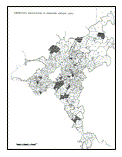Human Community

The research project of the Human Community (HUCO) commenced in 1961 with an attempt to study and categorize urban settlements at the micro-scale. The purpose of the project, as its name implies, was to identify, describe and finally prescribe, adequate ekistic units at the local neighborhood level, which can contribute to a residential environment within which the fulfillment of human values and needs is predominant.
The long experience of Doxiadis Associates, over a period of three decades, had resulted in the formulation of a progressive integration of communities in a hierarchical pattern.
The Human Community project used the rapidly expanding city of Athens as “laboratory” and its research team was engaged in a systematic analysis of the communities within this urban framework.
The methods employed included both field operations to acquire new data, as well as the analysis of existing reports and information. The operations in the field have consisted of four major undertakings: The Overall Survey, The Verification Operation, The Household Survey and subsequent Follow-up Surveys.
The Overall Survey (1961) was mainly based on field reconnaissance undertaken by planners familiar with an area. It provided a preliminary hierarchical structure of the communities in Athens.
The Verification Survey (1962) consisted of a complete census of facilities.
The Household Survey (1963) focused mainly on eliciting information from residents on the basis of a questionnaire administered to 3500 households in 18 sample communities (out of a total of 286) of Athens during the last six months of 1963.
This material formed the basis for a time-allocation study as well as for a study of residents’ satisfaction with their community. The findings could also be used for a subsequent launching of comprehensive effort in order to determine the relationship between urban design policy-making and satisfactoriness of community functioning.
The findings of the project were presented in a condensed form in various articles and lectures. The internal documents (reports, drafts, correspondence, graphs and maps) as well as the material of the household questionnaire are kept in the Constantinos A. Doxiadis Archives and are accessible to the researchers.